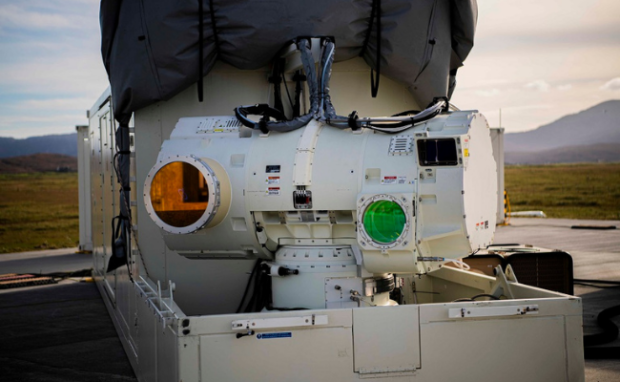UK laser weapon down aerial target
The United Kingdom’s Ministry of Defense announced the successful test firing of its high-powered DragonFire laser weapon against an aerial target. The institution hasn’t revealed its power and range, but an official statement says it can hit a “£1 coin from a kilometer away.” Soon, the country will deploy its new weapon to the battlefield.
Most believe laser weapons are only possible in science fiction stories like Star Wars. Contrary to popular belief, the United Kingdom, the United States, and China have been testing laser armaments for the next evolution of warfare. More importantly, it is a testament to how far laser technology has progressed that it is turning sci-fi into reality!
This article will explain why the United Kingdom is developing laser weapons. Later, I will share other combat laser projects from other countries.
Why make a laser weapon?

UK Defense Secretary Grant Shapp said, “This type of cutting-edge weaponry has the potential to revolutionize the battlespace by reducing the reliance on expensive ammunition while also lowering the risk of collateral damage.”
The UK MOD says DragonFire can take down targets at the speed of light by cutting through the target with an intense beam. Also, “Firing it for 10 seconds is the cost equivalent of using a regular heater for just an hour.”
“The cost of operating the laser is typically less than £10 per shot,” it added. For reference, £10 is roughly $12.73 or ₱720.59 at the time of writing.
The Ukraine-Russia War demonstrated the effectiveness of cheap drones in modern combat. Military update website Defense One says Ukrainian troops outfitted these flying machines with bombs to destroy critical Russian equipment.
They also used drones for covert surveillance of enemy combatants. IEEE Spectrum says these drones cost roughly $2,000, and many are available to civilians.
In contrast, a single British Spitfire cost £9,500 to produce in 1938, equivalent to about $1 million today. That is why more militaries are considering deploying drones in combat.
You may also like: Israel uses AI to facilitate military operations
A laser weapon is less likely to hit unintended targets like people or buildings. On the other hand, missile debris and stray bullets are more prone to causing collateral damage.
Dr. Nick Joad from the MOD’s Defence Science and Technology (DST) stated, “DragonFire provides a step-change in our ability to deal with high-performance and low-cost threats.”
Shimon Fhima, Director of Strategic Programmes for the MOD, said, “In a world of evolving threats, we know that our focus must be on getting capability to the warfighter, and we will look to accelerate this next phase of activity.”
Other laser weapon projects
Chinese scientists achieve laser weapon technology ‘breakthrough’ https://t.co/aA77jCMeg7 via @scmpnews If they have overcome the heating and distortion issues as claimed, in a (relatively) small enough unit for deployment, this is a big breakthrough considering the US… pic.twitter.com/bjAPebsAWw
— Steve Weaver 🇬🇧🇨🇳🏉 (@SteveWeaverTEFL) August 11, 2023
The United States is also developing a laser weapon, and they took inspiration from Star Wars. Defense company Lockheed Martin says it fires small beams into their component wavelengths.
The Debrief says the platform combines those beams into one 300 kW beam that can fry a drone’s electronics or burn off a beam. Also, it says Lockheed is boosting its power to 500 kW, strong enough to down cruise missiles.
China announced its new laser that fires nonstop. It is likely made possible by a cooling system explained in the journal Acta Optica Sinica. It “limited vibration and turbulence and enhanced mirror cleaning through improved structures and optimal gas flow.”
Futurism says it blows gas that blows through the weapon to remove excess heat. Another laser research paper from Yuan Shengfu describes this process as “film cooling.”
It reduces a laser weapon’s nozzle’s temperature by coating it with helium. As a result, weapons can fire laser beams indefinitely while maintaining performance.
You may also like: NASA tests laser communications system
Shengfu and his colleagues described past laser tech, saying, “Since the invention of the first ruby laser in 1960, people have been enthusiastic about transitioning from kinetic energy to laser energy for the rapid projection of energy at the speed of light, dreaming of laser beams to become ‘death rays’ that can instantly kill targets.”
“Unfortunately, 60 years have passed, and while various types of lasers have been developed, the application of high-energy laser systems has not been successful,” they added.
Conversely, the Chinese laser marks “a huge breakthrough in improving the performance of high-energy laser systems.”
Conclusion
The United Kingdom successfully tested its new laser weapon by taking down an aerial target. It claims the device is highly accurate and affordable, making it suitable for modern drone warfare.
Of course, lasers aren’t only for violence. For example, the US Department of Energy’s SLAC National Accelerator Laboratory uses an X-ray laser to study previously unobservable phenomena.
Learn more about the DragonFire weapon on the Ministry of Defense website. Also, check out the latest digital tips and trends at Inquirer Tech.